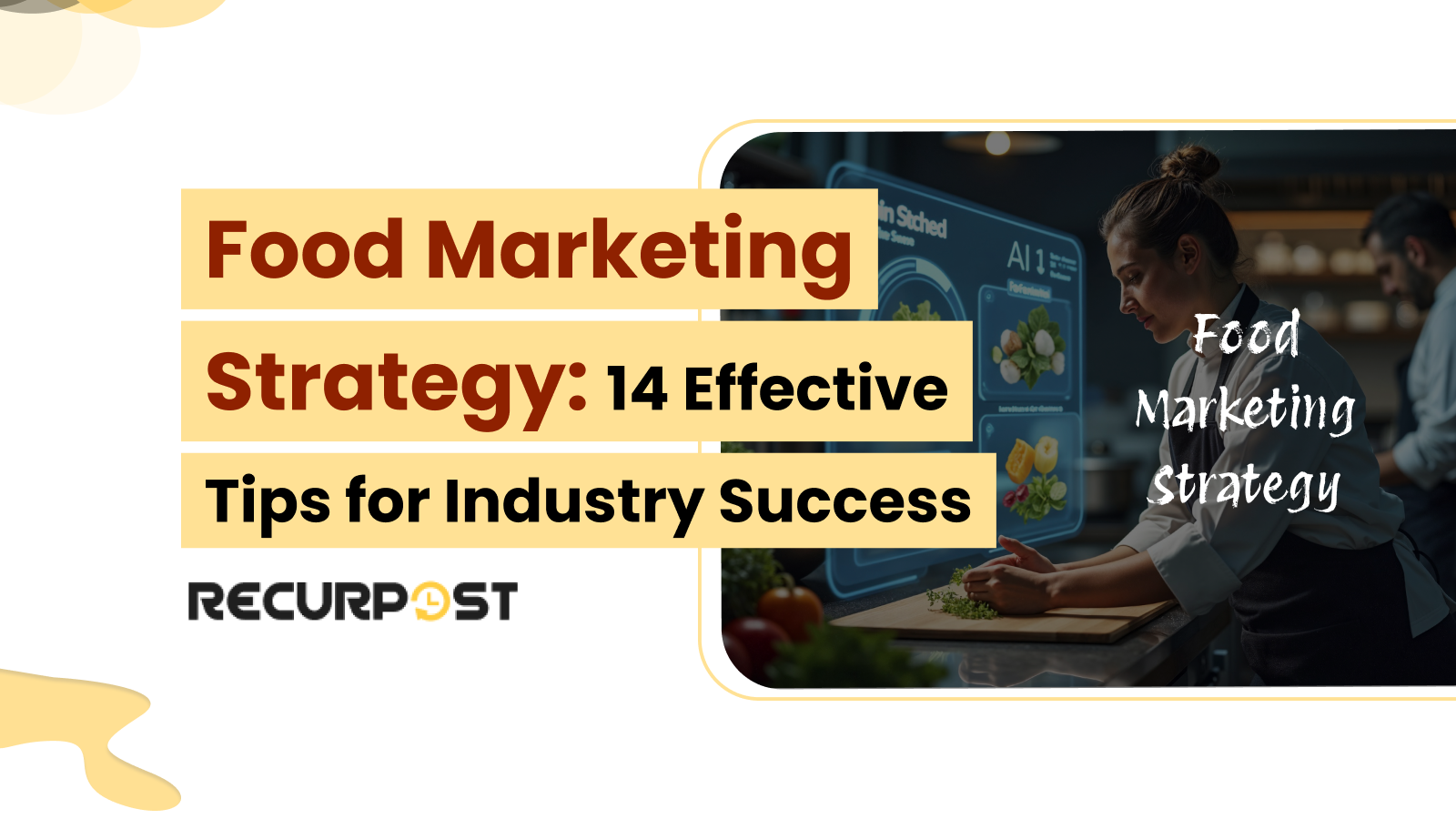Do you run a food company struggling with sales growth? Or are you planning a new food venture and searching for a food marketing strategy that shapes customer choices?
You may ask how to build a social media plan for your food business or how to use Instagram, TikTok, or Facebook to attract customers. Social media pushes food trends, builds brand loyalty, and can turn an ordinary menu item into a viral sensation.
In this blog, we will cover the basics of food marketing and share food marketing strategies that work in 2025, helping you grow into a standout name in the food industry.

Want to level up your food business' social media strategy?
RecurPost’s automation features can help you manage multiple accounts.
What is a Food Marketing Strategy?
A food marketing strategy is how companies promote products and shape consumer choices. It brings together packaging, promotion, and messaging to guide buying decisions.
Food Marketing Strategy Examples
Examples of food marketing strategies include influencer partnerships, creative packaging, seasonal campaigns, and loyalty programs. Social media connects food brands with audiences through stories and visuals, fueling awareness and repeat sales.
Food Marketing & Packaging
Packaging is a silent salesperson. Colors, graphics, and product claims shape how shoppers react. Bright colors like red and yellow make snacks look exciting, while earthy tones position organic products as natural and healthy. Packaging design can steer purchasing habits by making products easier to notice and trust.
Food Marketing Trends
Food promotion has shifted from word-of-mouth in the 1800s to digital-first channels in 2025. Trends like organic, vegetarian, and gluten-free influence product design and branding. Some companies also extend their brand into new items. For example, Heinz started with pickles but now sells ketchup, mustard, mayonnaise, and dressings.
Importance of social networking in marketing
Food Marketing & Messaging
Advertising shapes brand identity. Smucker’s jelly, for example, uses a family-first story in commercials to build trust and charge premium prices. Here’s a video ad that shows this positioning: Smucker’s Ad.
Brands succeed when they know their audience and position in the market. By reading customer preferences, they craft food marketing strategies that keep them competitive.
Social media marketing business plan
Food & Beverage Marketing Trends
Today’s food and beverage marketing trends include sustainability claims, short-form videos, and AI-driven personalization. Instagram Reels and TikTok now shape how people discover food brands. To stay relevant, companies refine plans through trend tracking, analytics, and customer feedback.
Marketing Strategy for Small Food Business
Small food businesses thrive by fostering community ties, offering limited-time promotions, and sharing personal stories. Behind-the-scenes clips and recipe posts can help establish trust on a limited budget. A steady social media presence turns local customers into loyal fans.
Social Media Marketing in the Food Industry
Social media shapes how food businesses connect with customers. Restaurants that lack strong websites often rely on digital campaigns to stay visible. Social platforms changed how people interact with food brands. A steady online presence and engaging content now matter as much as good food.
The majority of restaurant owners already use social media. Many food businesses create viral posts and visuals that attract attention and boost sales. Brands engage with consumers directly on these platforms, turning content into customer relationships and reinforcing their food marketing strategy.
Restaurants active on social media often build positive reputations in weeks instead of waiting months or years for recognition. Instagram shows this power. 30 percent of millennial diners skip restaurants with weak feeds. A distinct online brand has become vital for survival.
An active social media account for your food business creates these benefits:
- Customers can easily find your restaurant online.
- Meals and recipes can be shared visually to attract diners.
- A well-kept profile builds trust and credibility.
Small restaurants often see better results on Instagram than on Facebook.
Food Advertising Strategies Beyond Social Media
Social media drives food promotion today, but a food marketing strategy works best when it blends multiple channels. Successful food businesses pair social platforms with print, broadcast, and search ads to build awareness and sales.
Traditional and Digital Advertising Mix
A balanced food marketing strategy includes both traditional and digital formats:
- Print ads: Food magazines, local papers, and direct mail with tempting visuals and time-limited deals
- Outdoor ads: Billboards in high-traffic areas using clear, hunger-stirring images
- TV and radio: Short commercials that emphasize signature dishes or brand strengths
- Digital display: Targeted banners on food-related sites and apps
- Search engine ads: Paid campaigns for food-related keywords that capture ready-to-buy customers
Food Advertising Psychology
Food advertising works best when tied into a broader food marketing strategy that taps into basic triggers:
- Color use: Red and yellow stimulate appetite and catch attention
- Scarcity: Limited-time deals push customers to act fast
- Social proof: Ads with reviews and testimonials build trust
- Sensory language: Words describing taste, smell, or texture spark craving
- Lifestyle ties: Linking food with values or lifestyles deepens brand appeal
Every campaign should tie back to the brand identity and the core food marketing strategy guiding long-term growth.
How the Food Industry Uses Social Media Marketing
A strong food marketing strategy often relies on social platforms like Facebook, Instagram, TikTok, and Twitter. Food businesses connect with customers by:
- Sharing high-quality food photos that attract attention
- Posting seasonal, daily, or weekly menus
- Showcasing customer-generated posts
- Replying to customers to build relationships
- Sharing recipes that inspire repeat visits
- Posting behind-the-scenes photos and videos
- Featuring chefs, wait staff, bartenders, and team members
- Updating followers about new hours or changes
- Responding quickly to customer questions to maintain trust
Food company owners and beverage managers should maintain an active presence, sharing updates and cuisine highlights as part of their food marketing strategy. Facebook for Restaurants and other platforms can strengthen a brand’s food marketing strategy in the industry. A scheduling tool makes social posts easier to manage, ensuring the food marketing strategy stays consistent.
Digital Marketing for Food Businesses
Strong food businesses use digital marketing beyond social platforms. A well-rounded food marketing strategy builds visibility and keeps customers engaged across online channels.
Website Presence for Food Businesses
A website acts as a digital storefront within a food marketing strategy. It should:
- Feature professional food photography with good lighting and styling
- Include a simple menu with clear descriptions and prices
- Offer smooth online ordering or reservations
- Show customer reviews and testimonials
- Use local SEO keywords for nearby visibility
- Stay mobile-friendly for customers on the go
Email Marketing for Food Businesses
Email remains a strong part of any food marketing strategy. Businesses can:
- Send birthday offers and loyalty rewards
- Share newsletters with new menu items
- Send exclusive recipes or cooking tips
- Announce events, holiday menus, or limited-time deals
- Segment customers for tailored promotions
Search Visibility for Food Businesses
Appearing in searches supports discovery and a stronger food marketing strategy. Businesses should:
- Target food-related keywords with local intent
- Create location-specific landing pages
- Keep Google Business listings current with hours, photos, and menus
- Build backlinks from bloggers, local publications, and directories
- Post recipe content designed for featured snippets and voice search
Food Delivery App Marketing
Food delivery apps now shape buying habits. Adding them to a food marketing strategy helps businesses reach more customers:
- Create strong listings with professional food photography
- Add app-only deals to drive first orders
- Ask happy customers for reviews
- Track performance data and adjust menu items
- Add packaging inserts to push future direct orders
Blending digital tools with social media builds a complete food marketing strategy that reaches, retains, and grows customer bases. The media efforts create a cohesive online presence that attracts and retains customers throughout their digital journey.
Content Marketing in a Food Marketing Strategy
Content marketing builds brand trust, engages customers, and drives sales. It strengthens a food marketing strategy by attracting and keeping the right audience.
Types of Content for Food Businesses
Content within a food marketing strategy can take many forms:
- Recipes: Shareable dishes featuring your products
- How-to guides: Cooking techniques, preparation tips, or ingredient advice
- Behind-the-scenes: Stories about suppliers, staff, or production
- Educational: Nutrition, food pairing tips, or sustainability practices
- Seasonal: Holiday recipes, seasonal ingredient spotlights, or special occasion guides
Content Distribution Channels
A food marketing strategy spreads content across many platforms:
- Blog: Keep a regular blog on your site
- Email: Share newsletters directly with subscribers
- Social media: Tailor content for each platform
- Video: Post demos, taste tests, or chef interviews
- Podcasts: Share trends, interviews, or food stories
Content Marketing Success Metrics
Measure how content supports your food marketing strategy:
- Engagement: Comments, shares, or time spent with content
- Leads: Sign-ups, downloads, or coupon redemptions
- Sales: Conversions from content to purchase
- SEO: Organic traffic growth and better rankings
- Brand sentiment: Shifts in perception or loyalty
Content Calendar for Food Businesses
A planned calendar keeps a food marketing strategy consistent. Cover these themes:
- Seasonal dishes: Highlight what’s fresh and timely
- Holidays: Create posts for major food events
- Product spotlights: Feature new or signature items
- Customer stories: Share testimonials and user content
- Trends: Share your perspective on emerging food topics
Content marketing works best when it provides value. In a food marketing strategy, valuable content turns casual readers into loyal customers.
How Food Marketing Shapes Eating Habits Nationwide
A food marketing strategy surrounds consumers daily with messages that shape eating choices and influence buying behavior. When a food marketing strategy matches consumer preferences, it can guide healthier choices or push new food trends. A strong plan can:
- Create food trends that encourage you to:
(i) Buy certain foods or beverages
(ii) Collect loyalty points
(iii) Use coupons for future purchases
(iv) Earn rewards like movie or sports tickets - Link meals or brands to lifestyles
- Build brand loyalty so customers return to the same stores or brands
The next question is: what type of social media plan supports a food marketing strategy and raises customer engagement? The recommendations below share ideas.
Tips for a Social Media Strategy in Food Marketing
Even the best dishes need visibility. A social media presence strengthens a food marketing strategy and helps bring in steady traffic.
A strong social media plan builds awareness and drives visits. Restaurants should include it in their food marketing strategy because:
- 63% of restaurants already use social platforms
- 51% of consumers discover new restaurants through social media
- 37% of users research food brands and menus on social platforms before dining or ordering
Your potential customers already spend time on social platforms. These tips show how to fold social media into a food marketing strategy and keep your restaurant visible.
14 Tips to Use Social Media in a Food Marketing Strategy
1. Choose Social Media Platforms That Matter

A strong food marketing strategy begins with the right platforms. Facebook, Instagram, and Twitter remain leading choices.
- Facebook: 59% of users search for restaurants here.
- Instagram: diners engage most with food visuals.
- Twitter (X): users ask questions, leave feedback, and share quick impressions.
When setting up accounts, complete every profile field. Add location, hours, contact details, and a link to your website or menu. Visitors should find all key details at a glance.
2. Plan Your Content For Food Marketing
Profiles alone don’t draw traffic. Content fuels reach and customer interaction. Build a monthly calendar with images, videos, and captions to stay consistent.
- Share specials, seasonal menus, and behind-the-scenes moments.
- Mix short-form video with photos for variety.
- Use captions to tell quick food stories.
Example: Taco Bell’s Instagram feed showcases regular posts mixing humor, promotions, and product launches.
3. Strengthen Your Online Presence
Your website for food blogging acts as a digital storefront within a food marketing strategy. When people click from social media, they expect a responsive, updated page.
- Link directly to menus, ordering pages, or reservations.
- If no website, use Google Business to share hours, photos, and menus.
- Add a blog to share recipes or stories, which builds trust and SEO value.
4. Share High-Quality Photos & Videos

Visuals sell food better than words. With 93% of Instagram users saying product images influence purchases, photos and videos must look sharp.
- Post clear images of meals, drinks, and staff.
- Invest in professional photography or train staff on simple techniques.
- Use video for cooking demos, tours, or customer reactions. Video often doubles engagement compared to images alone.
5. Post at the Right Time

Timing shapes visibility. Posting a breakfast plate at midnight wastes reach.
- Test different slots until you see what works best.
- Use analytics to see when followers are active.
- Post around peak dining hours or just before meal times.
6. Run Contests & Giveaways

Giveaways attract attention and spread word-of-mouth fast. Choose rewards that feel valuable, such as free meals, discounts, or event tickets.
Ways to enter may include:
- Commenting on a giveaway post and tagging friends
- Sharing posts on their feed or stories
- Following your account for entry
Contests grow followers while building engagement for future campaigns.
7. Partner with Influencers

Influencer marketing continues to grow as part of many food marketing strategies. The right partner can bring hundreds of potential customers to your brand.
- Select influencers within your food niche.
- Check their audience for location and demographic match.
- Prioritize authenticity over follower counts.
The closer they are to your customer base, the stronger the impact.
8. Run Social Media Ads

Facebook, Instagram, YouTube, and Twitter all provide ad platforms. Among them, Facebook offers the most detailed targeting.
- Use geo-targeting to reach diners near your restaurant.
- Promote seasonal menus, special events, or delivery services.
- Track performance and adjust the budget toward ads that convert.
With 93% of business owners already running ads, this is proven ground for food businesses.
9. Repost Customer Content

Customer-generated posts create social proof. Diners trust real people more than polished ads.
- Share tagged posts or reviews on your page.
- Encourage content by offering discounts for tagged stories.
- Build a backlog of authentic posts to reuse during slower weeks.
This turns happy customers into micro-influencers.
10. Respond to Comments & Reviews

Unanswered reviews damage trust. With 71% of customers recommending brands that reply quickly, response speed matters.
- Thank positive reviewers publicly.
- Resolve complaints directly and quickly.
- Treat every comment as a chance to build trust.
Monitoring reviews regularly ensures issues don’t spiral.
11. Share Behind-the-Scenes Content

Behind-the-scenes posts make brands human. People enjoy seeing where their meals come from.
- Share videos of food prep, sourcing trips, or staff stories.
- Post about your sanitation process or how you select ingredients.
- Introduce staff with casual short videos.
This builds transparency and adds depth to your food marketing strategy.
12. Monitor Social Media Mentions

Social listening tools reveal how people talk about your restaurant. Tracking mentions from blogs, magazines, or influencers shows your reach.
- Use monitoring tools to track brand mentions.
- Study common themes in customer comments.
- Adjust your campaigns based on real conversations.
This feedback loop helps your food marketing strategy stay relevant.
13. Cross-Promote Accounts

Most brands perform better on one platform than others. Use strong accounts to help weaker ones grow.
- Link Instagram followers to your Facebook page.
- Use Twitter to drive blog traffic.
- Share TikTok videos across Instagram Reels.
Cross-promotion broadens your overall visibility without extra cost.
14. Showcase Your Team

People connect with people. Highlight staff preparing meals, serving tables, or interacting with customers.
- Post smiling staff portraits or group shots.
- Share clips of chefs cooking signature dishes.
- Celebrate milestones like staff anniversaries or awards.
A personal touch humanizes your brand and makes customers feel welcome.
Build a Food Marketing Plan
A structured food marketing strategy starts with a detailed plan. A clear plan works as a roadmap, aligning marketing efforts with business goals.
Step 1: Market Research & Analysis
Begin by collecting data that strengthens your food marketing strategy:
- Study audience demographics, preferences, and behaviors
- Review competitors’ pricing and marketing strategies
- Track industry trends and opportunities
- Measure current results and find gaps
Step 2: Define Clear Objectives
Set measurable goals that guide your food marketing strategy:
- Set sales goals for menu items
- Define acquisition and retention targets
- Track brand awareness with benchmarks
- Create timelines with milestones
Step 3: Craft Your Value Proposition
Clarify what sets your business apart within your food marketing strategy:
- Note selling points such as local ingredients or signature dishes
- Define brand voice and personality
- Position against competitors
- Create messages that resonate with your audience
Step 4: Budget & Resources
Allocate resources to keep your food marketing strategy realistic:
- Set a budget as a share of projected revenue
- Spread funds across channels with ROI in mind
- Assign tasks to team members
- Decide if outside partners are required
Step 5: Channel Planning
Choose channels and tactics that suit your food marketing strategy:
- Digital tools: website, SEO, email, social media
- Traditional ads: print, radio, outdoor
- Public relations and press outreach
- Store promotions and loyalty programs
- Community ties and partnerships
Step 6: Timeline for Execution
A timeline makes your food marketing strategy actionable:
- Schedule content creation and publishing
- Align campaigns with seasonal dates
- Match activities with product launches
- Review results at regular intervals
Step 7: Measurement & Adjustment
Track results and refine your food marketing strategy:
- Use KPIs for each goal
- Track results with reporting systems
- Hold regular review sessions
- Adjust underperforming initiatives
A structured food marketing strategy provides direction for all efforts. Review the plan quarterly to match market changes and shifting consumer needs.
Food Product Marketing Strategies
While restaurant promotion matters, packaged goods need a different food marketing strategy. Whether selling snacks, beverages, or specialty items, these steps help products gain visibility and share.
Packaging Design & Shelf Appeal
Packaging is the frontline of a food marketing strategy. It should:
- Use bold colors, shapes, or materials to stand out
- Share product benefits clearly at a glance
- Offer size variations for different needs
- Use windows or clear panels to show quality
- Test designs with consumers before launch
Retail Marketing Tactics
Retail placement strengthens a food marketing strategy by boosting visibility:
- Work with retailers for prime shelf space
- Build attractive point-of-purchase displays
- Use trial pricing or intro offers
- Host in-store demos and sampling
- Run retailer-focused promotions to gain support
E-commerce Product Marketing
A food marketing strategy also covers online sales:
- Write clear, benefit-led product descriptions
- Add high-quality images from multiple angles
- Share demo or usage videos
- Showcase verified customer reviews
- Add bundle deals or subscriptions for repeat sales
Product Sampling & Trial Generation
Trial programs are vital to a food marketing strategy for new products:
- Hand out samples at events or busy spots
- Partner with subscription boxes for trials
- Run “try before you buy” with guarantees
- Launch single-serve packs for low-risk testing
- Cross-promote with complementary brands
Product Line Extensions and Innovation
Innovation sustains a food marketing strategy:
- Launch seasonal or limited-edition flavors
- Expand into nearby categories using brand equity
- Adjust recipes to match new preferences
- Release premium or value versions for segments
- Test new concepts with small batches first
Food product marketing balances brand building with sales. A strong food marketing strategy blends long-term equity with short-term promotions.
Conclusion
Shifting search habits mean diners discover restaurants on social platforms first. A food marketing strategy built on social media keeps your restaurant visible when customers look for dining options. Applying these 14 tips builds engagement and ensures your brand stays top of mind.

Want to level up your food business' social media strategy?
RecurPost’s automation features can help you manage multiple accounts.
Frequently Asked Questions
1. How can I promote my food business?
A food marketing strategy for promotion combines online and offline efforts: build a website, use Google Business, post on social media, run geo-targeted ads, and encourage user-generated content.
2. What are the stages in the marketing of food?
A structured marketing strategy includes branding, raising awareness, running promotions, retaining customers, and collecting feedback through surveys or polls.
3. What are some good food marketing examples?
Brands like Taco Bell, McDonald’s, and Chipotle show how a food marketing strategy can use Gen Z campaigns, family appeal, and sustainability messaging to engage audiences.
4. How do you create a food marketing plan?
A simple marketing strategy plan starts with blogging, influencer outreach, seasonal offers, social contests, press releases, and promoting reviews across channels.
5. What are some food advertising strategies for social media?
A social food strategy uses visuals, influencer partnerships, limited-time offers, storytelling, customer content, and emotional appeal to connect with audiences.
6. What are some of the marketing strategies for small businesses?
A marketing strategy for small food businesses relies on local SEO, social media, appealing packaging, visuals, reviews, and affordable ads to grow reach.
7. What are some of the food marketing ideas?
Creative food marketing strategies include pop-up restaurants, interactive cooking videos, farm-to-table storytelling, recipe cards, and signature Instagram-worthy dishes.
8. What are some of the captions to promote a food business?
Sample captions for a food marketing strategy: “Savor the Flavor,” “From Farm to Fork,” or “Feast with Friends.”
9. What are some of the social media advertisement and marketing strategies for food and beverages?
A food and beverage marketing strategy on social media blends visuals, hashtags, influencer collaborations, contests, and targeted ads for a wide reach.
10. How to market your food business on social media?
Use a food marketing strategy with eye-catching posts, direct engagement, behind-the-scenes content, and tailored campaigns for your restaurant or brand.
11. How to market a food business?
Start by building an online presence with a website, local SEO, social media activity, and strong customer reviews to attract consistent buyers.
12. How to market a food product online?
Use e-commerce listings, optimized product descriptions, food bloggers, and targeted digital ads as part of your broader food marketing strategy.
13. How to promote your food business on Instagram?
Post high-quality visuals, short reels, and behind-the-scenes content. Pair them with influencer collaborations and branded hashtags to build reach.
14. How to advertise food on social media?
Run geo-targeted ads, seasonal promotions, and re-share customer posts to build awareness while keeping ads visually appealing and engaging.
15. How to use social media for restaurant marketing?
Restaurants thrive by sharing menu updates, showcasing staff, responding quickly to comments, and running promotions that connect directly with local diners.

Dr. Dinesh Agarwal, founder of RecurPost, holds a PhD in Cloud Computing and transitioned from academia to social media innovation in 2013. He built RecurPost into an enterprise-grade automation platform now used by over 100,000 businesses worldwide. Beyond leading RecurPost, Dr. Agarwal shares insights on social media marketing through talks, podcasts, and articles, with a focus on content optimization and algorithm-driven distribution.





